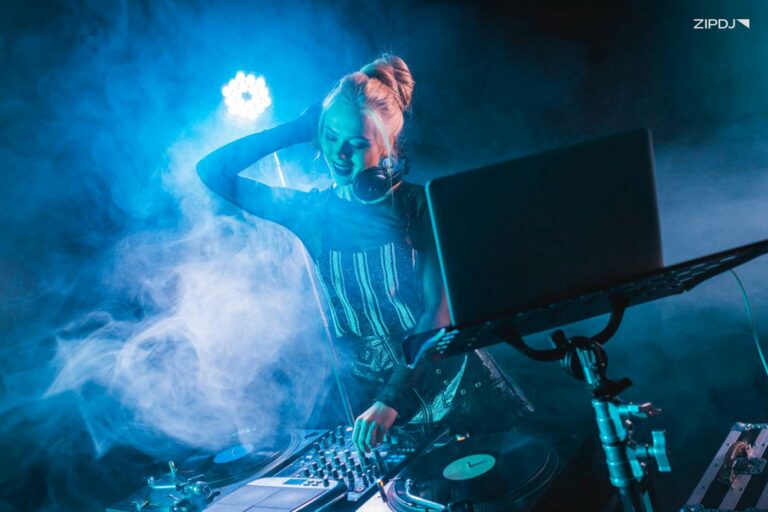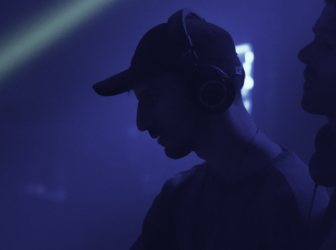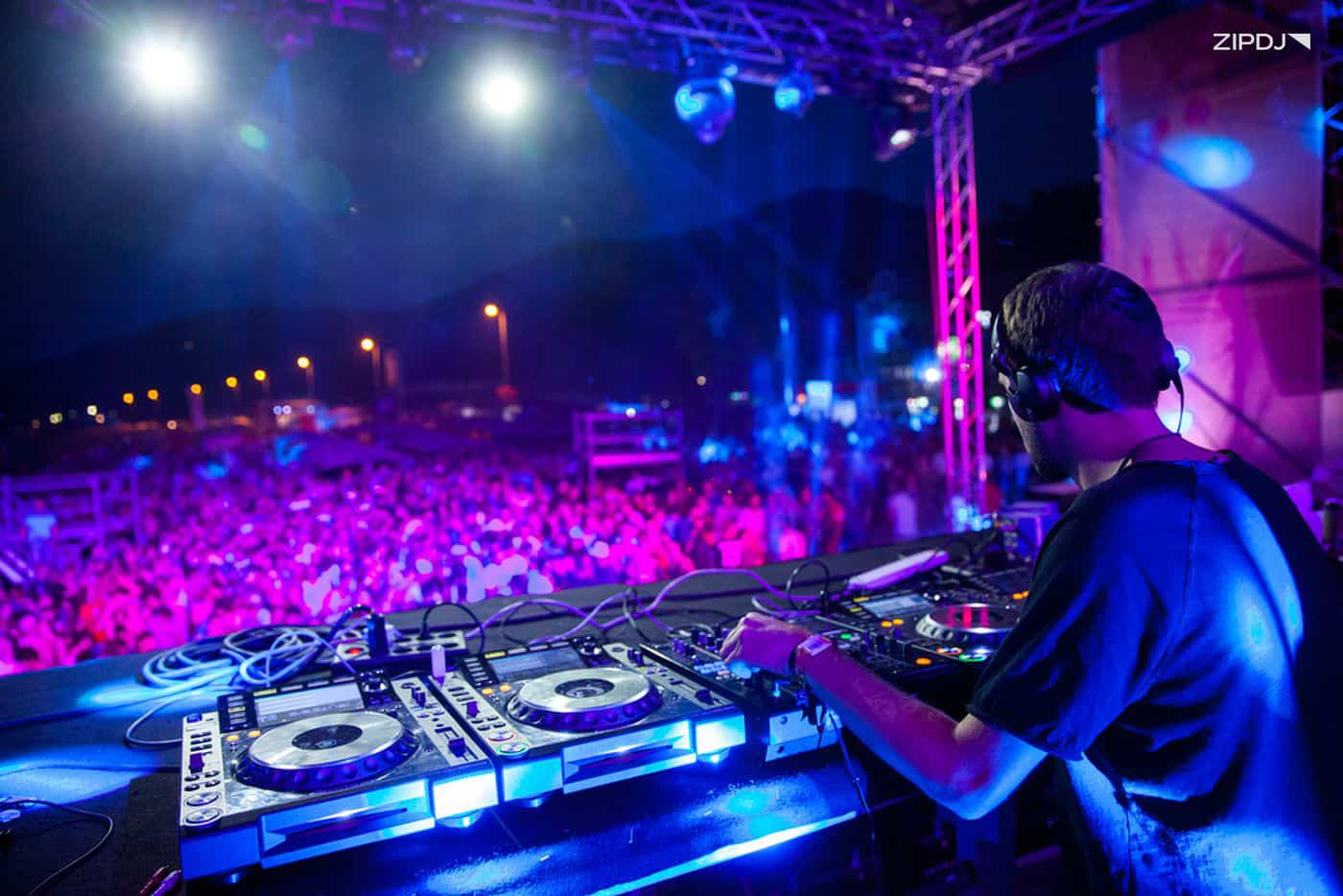House Vs EDM: What’s The Difference?

Electronic music has a rich and diverse history spanning decades, drawing influences from many different styles over the years.
By understanding the differences between house and EDM, DJs can build impressive music collections and manage their playlists for outstanding sets.
In this guide, we’ve explored the history and creative differences between house vs EDM, and the various subgenres you can incorporate into your DJ mixes.

House Vs EDM: Everything You Need To Know
Whatever your style of DJing, the role of house music and electronic dance music in the art form is impossible to understate.
Both genres have a deep and vibrant history in shaping the electronic music genres that DJs play to this day and continue to shape the music industry.
So, here’s everything you need to know about house vs EDM and how these genres can shape your DJing in 2025:
A Brief History of House Music & EDM
With dozens of electronic music genres available for DJs to explore, navigating the vast archives can seem daunting and time-consuming.
A great starting point is a breakdown of the differences and similarities between House and EDM, two of the most prominent genres today.
While there is some flexibility between house vs EDM, both terms cover a distinct range of dance music genres and have their own history and styles.
House music genres emerged during the 1980s, drawing influences from disco and quickly branching off into various popular subgenres.
On the other hand, electronic dance music, which also began in the 1980s, is slightly more difficult to pin down in terms of its origins and evolution.
Reflecting a diverse selection of styles, electronic dance music genres reflect a broader approach to music production and its evolution over time.
Despite these differences, DJs typically employ similar mixing techniques for house music and electronic dance music, whether using traditional turntables or DJ controllers.
Let’s explore the definitions and history of house music and EDM music before comparing the similarities and differences of these electronic music genres.
What Is House Music? (House Music Definition)
House music is arguably the oldest mainstream genre of electronic music in existence and has recently celebrated its 40th anniversary in Chicago.
Let’s break down how the genre has evolved over the decades, its typical music structure, and how technology has impacted DJs and producers.
House Music Origins In Chicago
The origins of house music date back to the 1970s, when the disco scene was at its peak, thanks to the popularity of the movie Saturday Night Fever.
Disco, which represented an underground music movement for the urban gay culture in New York City, was the first to make use of turntables in clubs.
By the late 1970s, disco had begun to fall out of fashion, with new producers and DJs merging many elements of the genre in a new style of music.
Referred to as house music, the style rose to prominence in Chicago, incorporating repetitive 4/4 bears and elements of disco, funk, and soulful vocals.
Before long, house music had become widespread in nightclubs in Chicago, New York, and other major cities around the United States.
Like disco, many of the best gay DJs got their break in the music industry in the house music scene, with Frankie Knuckles leading the way.
Early House Music Pioneers
The early pioneers of house music quickly dominated the scene and helped to define the genre’s core style and production characteristics.
Along with Frankie Knuckles, DJ producers such as Larry Heard and Larry Levan began expanding on emerging drum machines and sampling possibilities.
By the mid-1980s, house music had entered the mainstream discourse, with tracks such as “Move Your Body” by Marshall Jefferson dominating the airwaves.
This fertile environment also paved the way for some of the best DJ remixes, with high-profile collaborations between the genre’s leading artists.
The result was the emergence of various house music subgenres, with deep house, progressive house, electro house, and others entering the landscape.
Each of these styles took traditional house music as its template, adding new elements and production techniques that took the genre in exciting new directions.
Technological Advances & House Music
The art of DJing and the history of house music are intimately associated, and many of the core mixing techniques are still widely used today.
Pioneering DJs such as Frankie Knuckles and his peers became renowned for discovering new ways to mix, edit, and produce house music for their fans.
In the early days, reel-to-reel tape machines were required to remix elements from house tracks and introduce percussion, soulful vocals, and instruments.
As the technology around production developed, house music began to incorporate new techniques that electronic music producers still use today.
The rise of samples and effects processors widened the scope of possibilities, while affordable synthesizers could be used for impressive chord progressions.
Likewise, the ability to loop basslines and percussion, mix effects, and change tempo led to innovative house music releases over subsequent years.
What Is EDM Music? (EDM Definition)
As the name implies, electronic dance music is first and foremost geared toward creating an exciting and vibrant atmosphere on the dance floor.
Here’s an overview of its history, from its origins to the best EDM DJs active on the scene today, such as David Guetta and Swedish House Mafia.
Early Electronic Dance Music Categories
While house music can be traced back to the late 1970s and early 1980s, electronic dance music began its story in the late 1980s.
First emerging in the Detroit techno music scene, it has gone on to encompass a broad church of music styles over the following years.
Many of the best music genres adopted by DJs fall under the EDM umbrella, ranging from drum and bass and hardcore to trap, trance, and dubstep.
Some of the key pioneers of the early EDM scene include producers and DJs such as Juan Atkins, Dimitri Vegas, and Dave Nada.
These figures played a core role in establishing these EDM genres in the music industry and bringing them to a broader audience.
By the 1990s, the breadth and range of genres associated with EDM had expanded to cover ambient, hardstyle, future bass, and many more.
The Rise Of The Term “EDM”
The concept of electronic dance music has been in existence for many years, but the application of the term has a complex history and heritage.
Indeed, there’s much debate over the label’s etymology, which feeds into broader discussions about music genre categorization and labeling.
Exploring the history of DJ pools and their role in such categorization sheds some light on the evolution of the terminology.
Since record pools are designed to help club and radio DJs track down music efficiently, they offer deep insights into how music is effectively organized.
What began as a corporate term has evolved to cover a large selection of genres characterized by a dance floor sensibility and high energy.
Contemporary Examples Of Electronic Dance Music
While many genres associated with the term EDM have existed for decades, the term “electronic dance music” has changed over time.
Its popular modern context is most closely associated with contemporary producers such as David Guetta, Calvin Harris, and Skrillex.
This new generation of producers and DJs is best known for incorporating elements of pop music into their tracks, which delivers more mainstream appeal.
While house music DJs are often associated with the underground club scene, EDM DJs are more likely to perform at international festivals for a mainstream audience.
Like the catch-all term “electronic music,” it captures the zeitgeist of modern culture and the eclectic selection of producers and DJs in the scene.

Similarities Between House Music & EDM
While important distinctions must be made between the two core genres, house music, and EDM share several notable similarities.
Whether you’re considering becoming a house music DJ or playing multiple genres, understanding these similarities will help you develop a style.
Composition Structure
Whether analyzing house music or the range of EDM music available, there’s a consistent approach to the compositional structure of the tracks.
This uniformity is why DJs are able to beat-match across the spectrum of genres in their sets, creating smooth transitions from one style to the next.
Here are some of the core structural elements of house music and EDM that are generally similar across most music productions:
- Tempo range. The tempo of house and EDM music typically falls within the same range, covering approximately 120 to 130 beats per minute. This tempo range reflects the approximate elevated heart rate during dancing, which is why it positively affects the dance floor.
- Beat structure. Just as the tempo of both styles is within the same range, the overall beat structure remains consistent for most music released in both genres. Both use the 4/4 beat structure that allows for a steady and unbroken rhythm that connects to the dancer’s heartbeat through the generation of a steady groove.
- Intros and outros. Anyone who has DJed understands the facility offered by the intro and outro of a given track to help them smoothly mix tracks together. These sections are characterized by an emphasis on kick drums and percussion, with bass lines also sometimes included. They leave out complex melodies and chords from the structure since these can create key clashes when two tracks are combined.
- Breakdowns and drops. Because DJing involves building anticipation and releasing, house music and EDM commonly use breakdowns and drops in their structure. These build-ups use rising pitch, frenetic drums, and other techniques to heighten the audience’s anticipation before bringing the heavy-hitting percussion, basslines, and other elements back into the track.
These structural rules aren’t set in stone, and there are exceptions in both genres to be found, such as faster tempos for hard house and jungle music.
With that said, they apply to most music found within the house and EDM genres, which is why many DJs will experiment with both styles in their sets.
Venue Settings
We’ve explored the origins of house music and EDM and the context in which they emerged in various club scenes around the world over the years.
This context has remained consistent up to the present day, with most electronic music genres typically played in nightclubs and dance music festivals.
To this day, house music remains the most popular genre for clubs in the United Kingdom, dominating the scene around the country.
Subgenres such as electro-house, progressive house, and deep house are also widely played in nightclubs worldwide.
More niche subgenres, such as tech house, are also common fixtures in clubs, and many of the best underground DJs focus on this and techno.
EDM DJs are frequently found performing in the same types of venues as house music DJs, with residencies in the same major clubs.
More mainstream EDM DJs also headline dance music festivals such as Tomorrowland, Creamfields, and Ultra Music Festival alongside house DJs.
This reflects these genres’ broader crossover appeal with dance music fans, who often have eclectic tastes and favorite acts.
Approach To DJ Mixing
Since house music and EDM are both structured around the same basic rules of tempo and composition, they’re both mixed in similar ways.
Indeed, the history of DJing is deeply interwoven between these styles, incorporating many of the same mixing techniques for DJ sets.
Some of the foundational mixing techniques used by DJs for both EDM and house music include the following:
- Beat matching. Mixing tracks together requires both tracks to be matched in terms of their beats for DJs to perform seamless transitions. DJs achieve this either by ear when DJing on traditional turntables or using BPM displays on modern DJ controllers and other related hardware.
- Transitions. Blending from one track to the next is referred to as a transition, with EDM and house DJs both using seamless transitions as part of their common toolset. Typically, a DJ will utilize the EQ on the mixer to fade in and out elements such as the low-frequency kick drums and basslines. They will also manipulate the higher frequencies to balance the percussion and other elements, such as vocals, to avoid clashes.
- Use of filters and effects. Both EDM and house music DJs frequently use mixer features to add texture and effects to their sets, including filters and other effects units. Filter passes effectively control percussion and create more impactful transitions that enhance breakdowns and drops. Many mixers also feature effects such as choruses and flangers to add unique textures to synths and vocals when mixing.
- Harmonic mixing. When working with more melodic house music and commercial EDM, DJs will frequently use harmonic mixing to ensure vocals and melodies don’t clash. Most DJ equipment includes information relating to a track’s key to help DJs line up their mixes and use complementary keys when leading into transitions.
Since EDM is a relatively far-reaching term, it does include a handful of subgenres, such as drum and bass, that might use non-standard mixing techniques.
These are, however, outliers, and the vast majority of EDM music DJs will incorporate the traditional mixing techniques used for house music sets.
Differences Between House Music & EDM
The global electronic music scene continues to expand, with DJs continually looking for new ways to light up the dance floor and energize the audience.
By understanding the differences between house music and EDM, DJs can create mixes that effortlessly integrate these genres through seamless transitions.
Genre Definitions & Origins
We’ve discussed the history of EDM and house music and how they reflect common interests while reflecting divergent points of origin.
Their distinct genre definitions set them apart from one another both in their original purpose and the cultural aims of their creators.
House music is typically associated with some of the best old-school DJs who dominated underground clubs and the rave scene of the 1990s.
While EDM shared similar roots in the underground dance music scene, it is more commonly associated with mainstream music culture today.
Modern-day EDM producers and DJs are firmly within the mainstream corporate culture and have broad commercial appeal among casual music fans.
By contrast, house music is comparatively niche, confined to the same clubs and underground venues that characterized its early years.
Music Production Techniques
If the aforementioned core structure is a common ground between house music and EDM, this framework has many notable differences.
House and EDM might use similar tempos and beat structures, but the compositional tools can vary wildly, particularly in the diverse range of EDM subgenres.
As we’ve seen when exploring the history of house music, its roots lie within more traditional music genres such as soul, funk, and disco.
This is reflected in the use of traditional instruments, chord progressions, soul-like vocals, and jazz influences.
House tracks also often make liberal use of samples, taking short snippets from classic funk and soul music and using these in their productions.
By contrast, EDM typically takes a more synthetic approach to its compositions, using effects and filters more heavily on vocals.
For example, contemporary EDM tracks that hit the charts are best characterized by their use of vocoders and other tools to manipulate vocals.
Since EDM covers many more subgenres, there’s also a greater range of production techniques to be found that reflect this diversity.
Core Audience Appeal
House and EDM’s differences in core audience appeal are largely related to the distinction between niche and commercial interests.
While there’s no denying the huge influence that house music has had on electronic dance music, the latter has a much broader commercial appeal.
Indeed, electronic music is the third most popular genre in the world, reaching many millions of fans worldwide across the various subgenres.
The impressive mainstream popularity and appeal of modern-day EDM are clearly reflected in record sales and YouTube views of the leading acts.
Calvin Harris, Avicii, Skrillex, and others have reached hundreds of millions of views while regularly appearing on mainstream television and awards shows.
By contrast, the leading house music DJs are not often featured on such outlets and continue to be largely restricted to dedicated clubs.
The Future of House Music & EDM
With a wide range of factors affecting the future of music, house and EDM look set to continue to evolve in exciting new ways that reflect these changes.
Artificial intelligence is one important factor radically reshaping the music landscape, allowing producers to use new techniques.
Combined with the use of stem separation technology, these tools will revolutionize how DJ producers perform their roles in the studio and on stage.
If the past few years are any indication, the emergence of new subgenres is also inevitable as producers look to innovate and deliver fresh content.
Likewise, new DJing technology will further blur the line between DJ and live music performance, expanding on the currently available effects.
Other technological developments in the sphere of VR DJing will also create new opportunities for DJs to perform in online spaces.
Summary
The dance music scene is continually evolving to introduce new subgenres that reflect emerging technology and the blending of classic styles.
DJs can ensure their performances remain fresh and invigorating by drawing on the history outlined in this article to incorporate multiple subgenres in their sets.
By doing so, they can stay ahead of the curve and rise above the competition by capitalizing on new trends that showcase their unique taste and skills.
Not a member ?
Join Today for Unlimited Music Downloads. Visit zipdj.com for more information.



